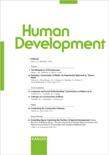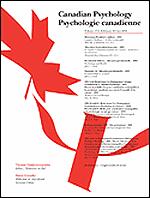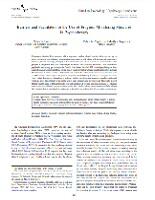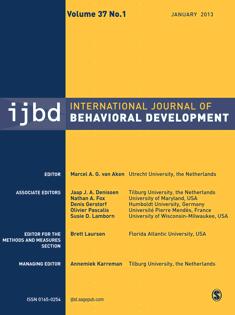Psychology
Related Works
Content type
Digital Document
Abstract
The core knowledge (CK) account of human development ascribes higher-order cognition to infants on the basis of looking time measures. In this paper, we investigate the conceptual foundations of this account through an examination of the preferential looking paradigm. We focus on the use of this paradigm in social cognitive and morality research, which involves ascriptions of expectation, surprise, preference, belief understanding, and moral judgment to infant looking behavior. We compare CK researchers’ usage of these terms with everyday usage, and conclude that the application of belief and morality to infant looking behavior is overzealous. Based on these considerations, we argue that a developmental systems approach may provide a more appropriate theoretical framework for studying the development of such capacities.
Origin Information
Content type
Digital Document
Abstract
Male rats carrying the testicular feminization mutation (Tfm-affected males) are insensitive to androgens, resulting in a female-typical peripheral phenotype despite possession of inguinal testes that are androgen secretory. Androgen-dependent neural and behavioral processes may likewise show atypical sexual differentiation. Interestingly, these mutant rats display elevated serum corticosterone, suggesting a chronic anxiety phenotype and dysregulated hypothalamic–pituitary–adrenal axis. In order to understand if elevated anxiety-like behavior is a possible mediating variable affecting the display of certain androgen-dependent behaviors, we compared the performance of Tfm-affected males to wild type males and females in the elevated plus maze (EPM). Two well-established indicators of anxiety-like behavior in the EPM were analyzed: total percentage of time spent on the open arms, and the percentage of open arm entries. We also analyzed the total number of open arm entries. Interestingly, Tfm-affected males spent less percentage of time on the open arms than both males and females, suggesting increased anxiety-like behavior. Percentage of open arm entries and the total number of arm entries was comparable between the groups, indicating that the observed decrease in the percentage of time spent on the open arms was not due to a global reduction in exploratory behavior. These data, in contrast to earlier reports, thus implicate androgen receptor-mediated functions in the expression of anxiety behaviors in male rats. Given that anxiety is widely reported as a precipitating factor in depression, studying the role of the androgen receptor in anxiety may give insights into the pathogenesis of major depressive disorder.
Origin Information
Content type
Digital Document
Abstract
(BACKGROUND).
Evidence that avoiding axillary lymph node dissection (AxD) strikes an appropriate balance between morbidity and recurrence risk in patients with invasive breast carcinoma generally is anecdotal and without a formally quantified basis. The current study presents a decision analysis of the difference in 5‐year disease free survival (DFS) rate between treatment scenarios with and without routine AxD.
(METHODS).
To derive quantitative estimates of the effect of avoiding AxD on 5‐year DFS, the authors examined outcomes for women undergoing 2 treatment scenarios: AxD or no AxD with adjuvant therapy decisions based on risk factors in the primary tumor. Eligible patients belonged to 2 lymph node metastases risk groups: low (patients without palpable lymph nodes and lymphatic or vascular invasion [LVI] negative tumors ≤ 0.5 cm in greatest dimension) and moderate (patients with mammographically detected, LVI negative tumors, between 0.6‐2.0 cm in greatest dimension or patients with palpable LVI negative tumors between 0.6‐1.0 cm in greatest dimension with nonpalpable lymph nodes). Along with observed data regarding treatment and recurrence, the authors employed estimates of the efficacy of chemotherapy, tamoxifen, and regional radiation therapy derived from published randomized trials to estimate the 5‐year DFS rate for treatment scenarios with and without AxD.
(RESULTS).
Patients in the low risk group had a 5% risk of lymph node metastases. In these women, eliminating AxD and treating no patients with chemotherapy and/or tamoxifen resulted in a < 1% decrease in the 5‐year DFS rate. Patients in the moderate risk group had a 10% risk of lymph node metastases. Eliminating AxD and treating only those women with Grade 3 tumors > 1 cm in greatest dimension with chemotherapy and/or tamoxifen resulted in a 1.8% decrease in the 5‐year DFS rate. However, if all patients in this group were treated with chemotherapy and/or tamoxifen and no AxD, the 5‐year DFS rate increased by 2.7%.
(CONCLUSIONS).
In patients with a low risk of lymph node metastases, it was estimated that eliminating AxD may result in only minimal changes in the estimated 5‐year DFS rate.
Origin Information
Content type
Digital Document
Abstract
This national survey investigated the clinical practice of psychologists in Canada with particular reference to the usage of progress monitoring (PM) measures. Data from 1,668 registered psychologists were collected on demographic characteristics, years of experience, years since graduation, degree, professional activities, primary clientele, theoretical orientations as well as familiarity with PM measures, usage of PM measures, and usage of other methods to monitor client progress. Survey results indicated that more than 2 thirds of psychologists were unfamiliar with PM measures and only 12% of psychologists were using these measures. Profiles of psychologists based on awareness and usage of PM measures are presented. Implications for practicing clinicians are discussed.
Origin Information
Content type
Digital Document
Abstract
Progress-monitoring (PM) measures, which help ensure evidence-based practice, allow the tracking of client progress in psychotherapy treatment and even predict which clients will have negative outcomes. However, the majority of psychologists in Canada still do not use these measures in clinical practice. The purpose of the present study was to investigate the barriers and facilitators to the use of PM measures in psychotherapy among psychologists in Canada. Participants included 533 licensed psychologists from across Canada who responded to an online survey regarding the barriers and facilitators involved in using PM measures in clinical practice. Participants self-identified as either users, nonusers, or previous users of PM measures. The results of the present study indicate that the top-4 barriers to using PM measures were limited knowledge, limitations in training, burden on clients, and concerns regarding additional work and time. These barriers were similar across users, nonusers, and previous users. The results suggest that offering training in different formats, over extended periods of time, and from colleague to colleague may be the most effective approach to overcoming these barriers. Other strategies that may help address the identified barriers and implications for practicing clinicians and the field of psychology are discussed.
Origin Information
Content type
Digital Document
Abstract
It is commonly assumed that the desire for a thin female physique and its pathological expression in eating disorders result from a social pressure for thinness. However, such widespread behavior may be better understood not merely as the result of arbitrary social pressure, but as an exaggerated expression of behavior that may have once been adaptive. The reproductive suppression hypothesis suggests that natural selection shaped a mechanism for adjusting female reproduction to socioecological conditions by altering the amount of body fat. In modern Western culture, social and ecological cues, which would have signaled the need for temporary postponement of reproduction in ancestral environments, may now be experienced to an unprecedented intensity and duration.
Origin Information
Content type
Digital Document
Abstract
Post-adoption service use and unmet service needs were examined longitudinally in three matched groups of children: children adopted from Romanian orphanages following a minimum of eight months' institutional experience (RO: n = 36); children from Romania who were destined for orphanages but were adopted early in infancy (EA: n = 25); and Canadian born non-adopted children (CB: n = 42). Data were collected when the adoptees had been in their adoptive homes for 11 months, at age 4.5 years and 10.5 years. Results indicated higher rates of service use and unmet service needs across time in the RO group. Unmet service needs in the RO group may be due in part to the unique challenges faced by post-institutionalized adoptees. Service use in the EA group jumped significantly at Phase 3, suggesting that the impact of their lesser degree of early deprivation was seen later in development under the additional challenge and stress of the demands of school. Findings, particularly from the EA group, supported the suggestion that adoptive parents have a lower threshold for referring their children for clinical services than do non-adoptive parents. Service needs of adoptees changed over time and those with unmet needs experienced greater challenges than those whose service needs were met.
Origin Information
Content type
Digital Document
Abstract
We examined behavior problems in 80 adolescents (39 male; mean age = 15.74 years) adopted in early childhood by Canadians from globally depriving Romanian institutions. Overall, rates of clinically significant behavior problems were comparable to rates found in younger postinstitutionalized adopted children. The association between duration of deprivation before adoption and behavior problems indicated relatively less lasting impact of deprivation on the behavior problems of adolescents who were adopted prior to 2 years of age. Measures of attachment, communicative openness about adoption, and exposure to culture of origin, which have been theoretically and, to a lesser extent, empirically linked to adjustment in postinstitutionalized adoptees were unrelated despite their apparent common conceptual link to sensitive parenting. Attachment and communicative openness were each significantly and negatively correlated with behavior problems; exposure to culture of origin was not. Hierarchical regressions revealed independent contributions of attachment and communicative openness to predicting behavior problems in postinstitutionalized adolescents.
Origin Information
Content type
Digital Document
Abstract
The Dark Triad Traits (DTT: consisting of Psychopathy, Machiavellianism, and Narcissism) are clearly linked to deceptive and manipulative behaviour, yet little is known about whether people with high levels of DTTs deceive themselves in order to convince others. This online study investigated whether the DTTs predicted false memory levels, assessed by the DRM paradigm (Deese, 1959: Deese & McDermott, 1995), which was modified to include three neutral word lists and three word lists constructed around DTT-related lures (Power, Control, and Status). The sample (n=161) consisted of 136 females and 25 males from the undergraduate research pool and through social networks. Among the three DTTs, psychopathy was most closely predictive of self-reported dishonesty. However, results showed that psychopathy and narcissism significantly predicted lower rates of adopting false memories for neutral lures, whereas Machiavellianism was somewhat predictive of adopting higher false memory levels, particularly for the DTT lure (control). These findings indicate that among the DTTs, psychopathy and narcissism are associated with a lower likelihood of self-deception, while Machiavellianism may increase the probability of self-deception.
Origin Information
Content type
Digital Document
Abstract
There is considerable evidence that people process information in a manner that favours prior beliefs, and that they are resistant to evidence against those beliefs. People who believed in an afterlife were recruited, and they all indicated their level of confidence. This study analyzed the effect of self-construal, mood, and nationality on openness to belief-contradicting evidence. Our study used a 2 (self-construal: rational vs fallible) X 2 (mood: positive vs negative) X 2 (nationality: Western vs non-Western) factorial design. Self-construal was manipulated through the use of questionnaires, while mood was manipulated with videos. All participants were exposed to arguments that contradicted their beliefs, and they indicated how convincing the arguments were. Their ratings of the arguments were our measure of openness to belief-contradicting evidence. There was a strong negative correlation between initial belief confidence and ratings of the arguments. Participants who were more confident in their beliefs tended to find the arguments unconvincing, but participants with less confidence tended to find the arguments convincing. Self-construal did not produce significant differences in ratings of the arguments, and neither did the mood manipulation. There was also no significant difference in average ratings between Westerners and non-Westerners. However, there was an unexpected interaction between nationality and self-construal. A fallible self-construal led to significantly lower ratings of the arguments for Westerners, while it led to higher ratings of the arguments for non-Westerners. Possible explanations of this finding are discussed, including identity threat and differences is self-serving bias.
Origin Information










